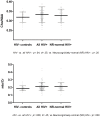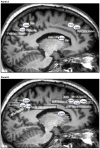HIV, vascular and aging injuries in the brain of clinically stable HIV-infected adults: a (1)H MRS study
- PMID: 23620788
- PMCID: PMC3631163
- DOI: 10.1371/journal.pone.0061738
HIV, vascular and aging injuries in the brain of clinically stable HIV-infected adults: a (1)H MRS study
Abstract
Background: Cardiovascular disease (CVD) and premature aging have been hypothesized as new risk factors for HIV associated neurocognitive disorders (HAND) in adults with virally-suppressed HIV infection. Moreover, their significance and relation to more classical HAND biomarkers remain unclear.
Methods: 92 HIV- infected (HIV+) adults stable on combined antiretroviral therapy (cART) and 30 age-comparable HIV-negative (HIV-) subjects underwent (1)H Magnetic Resonance Spectroscopy (MRS) of the frontal white matter (targeting HIV, normal aging or CVD-related neurochemical injury), caudate nucleus (targeting HIV neurochemical injury), and posterior cingulate cortex (targeting normal/pathological aging, CVD-related neurochemical changes). All also underwent standard neuropsychological (NP) testing. CVD risk scores were calculated. HIV disease biomarkers were collected and cerebrospinal fluid (CSF) neuroinflammation biomarkers were obtained in 38 HIV+ individuals.
Results: Relative to HIV- individuals, HIV+ individuals presented mild MRS alterations: in the frontal white matter: lower N-Acetyl-Aspartate (NAA) (p<.04) and higher myo-inositol (mIo) (p<.04); in the caudate: lower NAA (p = .01); and in the posterior cingulate cortex: higher mIo (p<.008- also significant when Holm-Sidak corrected) and higher Choline/NAA (p<.04). Regression models showed that an HIV*age interaction was associated with lower frontal white matter NAA. CVD risk factors were associated with lower posterior cingulate cortex and caudate NAA in both groups. Past acute CVD events in the HIV+ group were associated with increased mIo in the posterior cingulate cortex. HIV duration was associated with lower caudate NAA; greater CNS cART penetration was associated with lower mIo in the posterior cingulate cortex and the degree of immune recovery on cART was associated with higher NAA in the frontal white matter. CSF neopterin was associated with higher mIo in the posterior cingulate cortex and frontal white matter.
Conclusions: In chronically HIV+ adults with long-term viral suppression, current CVD risk, past CVD and age are independent factors for neuronal injury and inflammation. This suggests a tripartite model of HIV, CVD and age likely driven by chronic inflammation.
Conflict of interest statement
Figures




References
-
- National Centre in HIV Epidemiology and Clinical Research (2010) HIV, viral hepatitis and sexually transmissible infections in Australia Annual Surveillance Report 2010. Sydney, NSW. - PubMed
-
- Murray JM, McDonald AM, Law MG (2009) Rapidly ageing HIV epidemic among men who have sex with men in Australia. Sex Health 6: 83–86. - PubMed
-
- Mothobi NZ, Brew BJ (2012) Neurocognitive dysfunction in the highly active antiretroviral therapy era. Curr Opin Infect Dis 25: 4–9. - PubMed
Publication types
MeSH terms
Substances
LinkOut - more resources
Full Text Sources
Other Literature Sources
Medical
Miscellaneous

